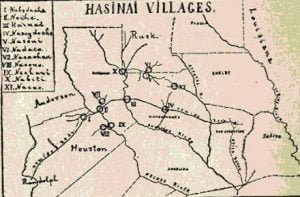The Locations of the Hasinai Confederacy
For determining the location of these tribes our chief materials are the Journal of Joutel (1687), the Relación of Francisco de Jesus Maria Casañas (1691), De Leon’s diary of the expedition of 1690, Terán’s for that of 1691-2, those of Ramon and Espinosa for the expedition of 1716, Pena’s for that of Aguayo (1721), Rivera’s for his visita of 1727, Solis’s for that made by him in 1767-8, and Mezières accounts of his tours among the Indians in 1772, 1778, and 1779. Two only of these are in print, while two of them have not before been used. Besides these … Read more

